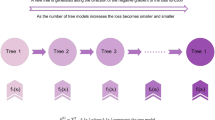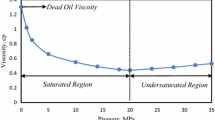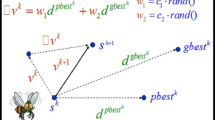Abstract
In this study, experimental measurements and modeling investigations were performed to predict crude oil viscosity under a wide range of conditions. For this purpose, after measuring the viscosity of a considerable number of Iranian crude oils, three advanced intelligent models, including group method of data handling optimized by genetic algorithm, artificial neural network and Gaussian process regression were developed to estimate saturated and under-saturated oil viscosity by considering crude oil API, solution gas oil ratio, bubble point pressure, molecular weight and specific gravity of C12+ fraction, mole percent of \(C_{11}^{ - }\)components, temperature and pressure as input parameters. To assess the ability of the proposed intelligent approaches, a wide variety of statistical and graphical error analyses were applied. The results demonstrated that the Gaussian process regression model with average absolute relative errors of 0.18 and 0.07% for saturated and under-saturated oil, respectively, had the best performance in viscosity prediction under different circumstances. Also, the findings of the Leverage technique, which was implemented for detection of suspected data, indicated the reliability of all measured data. Moreover, the results of sensitivity analysis showed that API, pressure and temperature had the greatest effect on oil viscosity in both saturated and under-saturated conditions.





















Similar content being viewed by others
References
Abedini, R., Esfandyari, M., Nezhadmoghadam, A., & Rahmanian, B. (2012). The prediction of undersaturated crude oil viscosity: An artificial neural network and fuzzy model approach. Petroleum Science and Technology, 30(19), 2008–2021.
Ahmadi, M. A., & Golshadi, M. (2012). Neural network based swarm concept for prediction asphaltene precipitation due to natural depletion. Journal of Petroleum Science and Engineering, 98–99, 40–49.
Ahmed, T. (2019). Reservoir engineering handbook. Gulf Professional Publishing.
Akbari, M., Asadi, P., Besharati Givi, M. K., & Khodabandehlouie, G. (2014). Artificial neural network and optimization. In M. K. Besharati Givi & P. Asadi (Eds.), Advances in friction-stir welding and processing (pp. 543–599). Woodhead Publishing.
Al-Khafaji, A. H., Abdul-Majeed, G. H., & Hassoon, S. F. (1987). Viscosity correlation for dead, live and undersaturated crude oils. Journal of Petroleum Research, 6(2), 1–16.
Al-Marhoun, M. A., Nizamuddin, S., Abdul Raheem, A. A., Shujath Ali, S., & Muhammadain, A. A. (2012). Prediction of crude oil viscosity curve using artificial intelligence techniques. Journal of Petroleum Science and Engineering, 86–87, 111–117.
Bahonar, E., Chahardowli, M., Ghalenoei, Y., & Simjoo, M. (2022). New correlations to predict oil viscosity using data mining techniques. Journal of Petroleum Science and Engineering, 208(E), 109736.
Bahrami, P., Kazemi, P., Mahdavi, S., & Ghobadi, H. (2016). A novel approach for modeling and optimization of surfactant/polymer flooding based on genetic programming evolutionary algorithm. Fuel, 179, 289–298.
Beal, C. (1946). The viscosity of air, water, natural gas, crude oil and its associated gases at oil field temperatures and pressures. Transactions of the AIME, 165(1), 94–115.
Beggs, H. D., & Robinson, J. R. (1975). Estimating the viscosity of crude oil systems. Journal of Petroleum Technology, 27(9), 1140–1141.
Chen, G., Fu, K., Liang, Z., Sema, T., Li, C., Tontiwachwuthikul, P., & Idem, R. (2014). The genetic algorithm based back propagation neural network for MMP prediction in CO2-EOR process. Fuel, 126, 202–212.
Dave, V. S., & Dutta, K. (2014). Neural network based models for software effort estimation: a review. Artificial Intelligence Review, 42, 295–307.
Dutta, S., & Gupta, J. P. (2010). PVT correlations for Indian crude using artificial neural networks. Journal of Petroleum Science and Engineering, 72(1–2), 93–109.
Elsharkawy, A. M., & Alikhan, A. A. (1999). Models for predicting the viscosity of Middle East crude oils. Fuel, 78(8), 891–903.
Fu, Q., Shen, W., Wei, X., Zheng, P., Xin, H., & Zhao, C. (2019). Prediction of the diet nutrients digestibility of dairy cows using Gaussian process regression. Information Processing in Agriculture, 6(3), 396–406.
Ghorbani, B., Ziabasharhagh, M., & Amidpour, M. (2014). A hybrid artificial neural network and genetic algorithm for predicting viscosity of Iranian crude oils. Journal of Natural Gas Science and Engineering, 18, 312–323.
Glaso, O. (1980). Generalized pressure-volume-temperature correlations. Journal of Petroleum Technology, 32(5), 785–795.
Goldberg, D. E. (1989). Genetic algorithms in search, optimization and machine learning. Addison-Wesley.
Hadavimoghaddam, F., Ostadhassan, M., Heidaryan, E., Sadri, M. A., Chapanova, I., Popov, E., Cheremisin, A., & Rafieepour, S. (2021). Prediction of dead oil viscosity: Machine learning vs. classical correlations. Energies, 14(4), 930.
Hemmati-Sarapardeh, A., Shokrollahi, A., Tatar, A., Gharagheizi, F., Mohammadi, A. H., & Naseri, A. (2014a). Reservoir oil viscosity determination using a rigorous approach. Fuel, 116, 39–48.
Hemmati-Sarapardeh, A., Majidi, S. M., Mahmoudi, B., Ramazani, S. A., & Mohammadi, A. H. (2014b). Experimental measurement and modeling of saturated reservoir oil viscosity. Korean Journal of Chemical Engineering, 31, 1253–1264.
Hemmati-Sarapardeh, A., Ghazanfari, M. H., Ayatollahi, S., & Masihi, M. (2016a). Accurate determination of the CO2-crude oil minimum miscibility pressure of pure and impure CO2 streams: A robust modelling approach. The Canadian Journal of Chemical Engineering, 94, 253–261.
Hemmati-Sarapardeh, A., Ameli, F., Dabir, B., Ahmadi, M., & Mohammadi, A. H. (2016b). On the evaluation of asphaltene precipitation titration data: Modeling and data assessment. Fluid Phase Equilibria, 415, 88–100.
Holland, J. H. (1975). Adaptation in natural and artificial systems: An introductory analysis with applications to biology, control, and artificial intelligence. University of Michigan Press.
Hossain, M. S., Sarica, C., Zhang, H. Q., Rhyne, L., & Greenhill, K. L., (2005). Assessment and development of heavy oil viscosity correlations. In SPE International Thermal Operations and Heavy Oil Symposium, Alberta, Canada.
Hosseinifar, P., & Jamshidi, S. (2016). A new correlative model for viscosity estimation of pure components, bitumens, size-asymmetric mixtures and reservoir fluids. Journal of Petroleum Science and Engineering, 147, 624–635.
Ivakhnenko, A. G. (1968). The group method of data handling—A rival of the method of stochastic approximation. Soviet Automatic Control, 13(3), 43–55.
Ivakhnenko, A. G. (1971). Polynomial theory of complex systems. IEEE Transactions on Systems, Man, and Cybernetics, 1(4), 364–378.
Kartoatmodjo, T., & Schmidt, Z. (1994). Large data bank improves crude physical property correlations. Oil & Gas Journal, 92(27), 51–55.
Khamehchi, E., Mahdiani, M. R., Amooie, M. A., & Hemmati-Sarapardeh, A. (2020). Modeling viscosity of light and intermediate dead oil systems using advanced computational frameworks and artificial neural networks. Journal of Petroleum Science and Engineering, 193, 107388.
Labedi, R. (1992). Improved correlations for predicting the viscosity of light crudes. Journal of Petroleum Science and Engineering, 8(3), 221–234.
Mahdaviara, M., Rostami, A., Keivanimehr, F., & Shahbazi, K. (2021). Accurate determination of permeability in carbonate reservoirs using Gaussian process regression. Journal of Petroleum Science and Engineering, 196, 107807.
Mahdiani, M. R., Khamehchi, E., Hajirezaie, S., & Hemmati-Sarapardeh, A. (2020). Modeling viscosity of crude oil using k-nearest neighbor algorithm. Advances in Geo-Energy Research, 4(4), 435–447.
McCain, W. D., Jr. (1990). The properties of petroleum fluids. PennWell Publishing Company.
Mehrjoo, H., Riazi, M., Nait Amar, M., & Hemmati-Sarapardeh, A. (2020). Modeling interfacial tension of methane-brine systems at high pressure and high salinity conditions. Journal of the Taiwan Institute of Chemical Engineers, 114, 125–141.
Mohammadi, A. H., Eslamimanesh, A., Gharagheizi, F., & Richon, D. (2012). A novel method for evaluation of asphaltene precipitation titration data. Chemical Engineering Science, 78, 181–185.
Nait Amar, M., Ghahfarokhi, A. J., Ng, C. S. W., & Zeraibi, N. (2021). Optimization of WAG in real geological field using rigorous soft computing techniques and nature-inspired algorithms. Journal of Petroleum Science and Engineering, 206, 109038.
Nait Amar, M., Djema, H., Belhaouari, S. B., & Zeraibi, N. (2022). Modeling of methane adsorption capacity in shale gas formations using white-box supervised machine learning techniques. Journal of Petroleum Science and Engineering, 208, 109226.
Nait Amar, M., Ouaer, H., & Ghriga, M. A. (2022). Robust smart schemes for modeling carbon dioxide uptake in metal organic frameworks. Fuel, 311, 122545.
Naseri, A., Nikazar, M., Mousavi Dehghani, S. A., & Dehghani, S. A. M. (2005). A correlation approach for prediction of crude oil viscosities. Journal of Petroleum Science and Engineering, 47(3–4), 163–174.
Naseri, A., Yousefi, S. H., Sanaei, A., & Gharesheikhlou, A. A. (2012). A neural network model and an updated correlation for estimation of dead crude oil viscosity. Brazilian Journal of Petroleum and Gas, 6(1), 31–41.
Ng, C. S. W., Djema, H., Nait Amar, M., & Ghahfarokhi, A. J. (2022). Modeling interfacial tension of the hydrogen-brine system using robust machine learning techniques: Implication for underground hydrogen storage. International Journal of Hydrogen Energy, 47(93), 39595–39605.
Oloso, M. A., Hassan, M. G., Bader-El-Den, M. B., & Buick, J. M. (2018). Ensemble SVM for characterization of crude oil viscosity. Journal of Petroleum Exploration and Production Technology, 8, 531–546.
Onwubolu, G. C. (2009). Hybrid self-organizing modeling systems. Springer.
Padilha, C. E. A., Padilha, C. A. A., Souza, D. F. S., de Oliveira, J. A., de Macedo, G. R., & dos Santos, E. S. (2015). Prediction of rhamnolipid breakthrough curves on activated carbon and Amberlite XAD-2 using artificial neural network and group method data handling models. Journal of Molecular Liquids, 206, 293–299.
Petrosky, G. E., & Farshad, F. F. (1995). Viscosity correlations for gulf of Mexico crude oils. SPE Production Operations Symposium.
Rammay, M. H., & Abdulraheem, A. (2017). PVT correlations for Pakistani crude oils using artificial neural network. Journal of Petroleum Exploration and Production Technology, 7, 217–233.
Rasmussen, C. E., & Williams, C. K. I. (2006). Gaussian processes for machine learning. MIT Press.
Razghandi, M., Hemmati-Sarapardeh, A., Rashidi, F., Dabir, B., & Shamshirband, S. (2019). Smart models for predicting under-saturated crude oil viscosity: A comparative study. Energy Sources, Part A: Recovery, Utilization, and Environmental Effects, 41(19), 2326–2333.
Rousseeuw, P. J., & Leroy, A. M. (1987). Robust regression and outlier detection. John Wiley and Sons.
Sadi, M. (2018). Determination of heat capacity of ionic liquid based nanofluids using group method of data handling technique. Heat and Mass Transfer, 54, 49–57.
Sadi, M., & Shahrabadi, A. (2018). Evolving robust intelligent model based on group method of data handling technique optimized by genetic algorithm to predict asphaltene precipitation. Journal of Petroleum Science and Engineering, 171, 1211–1222.
Sadi, M., Dabir, B., & Shahrabadi, A. (2008). Multiobjective optimization of polymerization reaction of vinyl acetate by genetic algorithm technique with a new replacement criterion. Polymer Engineering and Science, 48, 853–859.
Sadi, M., Fakharian, H., Ganji, H., & Kakavand, M. (2019). Evolving artificial intelligence techniques to model the hydrate-based desalination process of produced water. Journal of Water Reuse and Desalination, 9(4), 372–384.
Sánchez-Minero, F., Sánchez-Reyna, G., Ancheyta, J., & Marroquin, G. (2014). Comparison of correlations based on API gravity for predicting viscosity of crude oils. Fuel, 138, 193–199.
Sinha, U., Dindoruk, B., & Soliman, M. (2020). Machine learning augmented dead oil viscosity model for all oil types. Journal of Petroleum Science and Engineering, 195, 107603.
Stratiev, D., Nenov, S., Sotirov, S., Shishkova, I., Palichev, G., Sotirova, E., Ivanov, V., Atanassov, K., Ribagin, S., & Angelova, N. (2022). Petroleum viscosity modeling using least squares and ANN methods. Journal of Petroleum Science and Engineering, 212, 110306.
Stratiev, D., Shishkova, I., Dinkov, R., Nenov, S., Sotirov, S., Sotirova, E., Kolev, I., Ivanov, V., Ribagin, S., Atanassov, K., Stratiev, D., Yordanov, D., & Nedanovski, D. (2023). Prediction of petroleum viscosity from molecular weight and density. Fuel, 331, 125679.
Talebkeikhah, M., Nait Amar, M., Naseri, A., Humand, M., Hemmati-Sarapardeh, A., Dabir, B., & Ben Seghier, M. E. A. (2020). Experimental measurement and compositional modeling of crude oil viscosity at reservoir conditions. Journal of the Taiwan Institute of Chemical Engineers, 109, 35–50.
Torabi, F., Abedini, A., & Abedini, R. (2011). The development of an artificial neural network model for prediction of crude oil viscosities. Petroleum Science and Technology, 29(8), 804–816.
Williams, C. K. I., & Rasmussen, C. E. (1996). Gaussian processes for regression. In D. S. Touretzky, M. C. Mozer, & M. E. Hasselmo (Eds.), Advances in neural information processing systems 8 (pp. 514–520). MIT Press.
Author information
Authors and Affiliations
Corresponding author
Ethics declarations
Conflict of Interests
The authors have no known competing interests to declare that are relevant to the content of this article.
Supplementary Information
Below is the link to the electronic supplementary material.
Rights and permissions
Springer Nature or its licensor (e.g. a society or other partner) holds exclusive rights to this article under a publishing agreement with the author(s) or other rightsholder(s); author self-archiving of the accepted manuscript version of this article is solely governed by the terms of such publishing agreement and applicable law.
About this article
Cite this article
Sadi, M., Shahrabadi, A. Experimental Measurement and Accurate Prediction of Crude Oil Viscosity Utilizing Advanced Intelligent Approaches. Nat Resour Res 32, 1657–1682 (2023). https://doi.org/10.1007/s11053-023-10204-5
Received:
Accepted:
Published:
Issue Date:
DOI: https://doi.org/10.1007/s11053-023-10204-5




